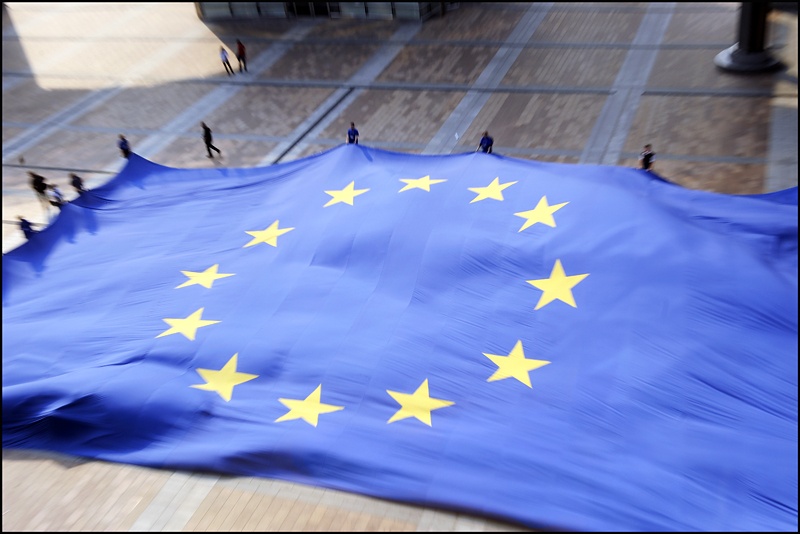The EU as a Prospective Permanent Observer to the Arctic Council: Footholds, Virtues, Concerns and Obstacles (Part 1)

EU flag in the Guinness Book of Records on 14 April 2009. Photo: Pietro Naj-Oleari
The European Union is one of the most prominent candidates for becoming a permanent observer to the Arctic Council. The acceptance of the Union’s application will most likely be decided at the next Ministerial Meeting of the Arctic Council in Kiruna, Sweden in May 2013. While a lot of politics underpin this decision, hardly any attention has been devoted to a deeper discussion of the EU’s potential role and contribution as a permanent observer to the Arctic Council. This article aims to provide such a discussion by outlining the multiple footholds the EU already has with both Arctic states and within Arctic-related issue areas, and a number of obstacles and concerns that are related to this institutional inclusion of the EU in the Arctic’s most prominent political body.
Footholds linking the EU to the Arctic can be divided into geographical/institutional links and policy-issue links. Concerning the former, three EU member states, Sweden, Finland and Denmark are members of the Arctic Council. This group could be extended to four with the possible accession of Iceland into the EU. However, recent polls show a majority of Icelanders against eventual Icelandic EU membership, and fishing remains a contentious issue between the EU and Iceland.1)
Two further Arctic Council members are EEA/EFTA members, Iceland and Norway. However, the EEA is not applicable to the Svalbard Archipelago and the common fisheries policy is excluded from the EEA internal market. Greenland belongs to the EU’s Overseas Countries and Territories (OCTs), which is an associate status including support for social and economic development. There is a comprehensive Greenland-EU partnership, including for example a Fisheries Partnership Agreement and a recently signed cooperation agreement on raw materials.2)
The EU’s regional development policy is of relevance to the Arctic. Various programmes with relevance for the Arctic receive funding from the European Regional Development Fund, the European Social Fund or the Cohesion Fund. A concrete example is the Interreg IV Northern Periphery programme, which focuses on promoting innovation and competitiveness in remote and peripheral areas and sustainable development of natural and community resources, whose members include Finland, Ireland, United Kingdom, Sweden, Faroe Islands, Greenland, Iceland and Norway.
More generally, the EU has acquired a broad array of decision-making powers from its member states, powers that partly extend to Iceland and Norway via the EEA Agreement. The EU has also become a relevant actor in international negotiations and treaty making processes, which are of relevance for Arctic governance, such as the Convention on Biological Diversity.
It would also make sense to include the EU more in Arctic governance to facilitate learning processes, on the one hand for the EU to sensitise its policies and discourses to Arctic realities and for other Arctic actors to understand how the Union works. As Koivurova et al wrote recently, the “EU has developed its Arctic policy in the last few years, and gradual institutional learning will probably improve the quality of its input in the Arctic governance and its understanding of the policy dynamics prevailing in the Arctic and the social and environmental realities in the region”.3)
A prominent example is the EU ban on seal products from commercial hunting, which reveals a lack of knowledge and interaction between Arctic and non-Arctic parties. The case demonstrates that the EU is making, and will make, decisions that influence the development of the region irrespective of whether it is further involved in the Arctic Council. In contrast to how the ban on seal products is usually perceived, it can thus be seen as supporting the case for stronger involvement of the EU in Arctic governance.4)

The EU is also already involved in a multitude of Arctic-relevant policy areas. The most pressing issues in the Arctic are related to environmental problems, which have been caused by outside or ‘southern’ sources, such as long range trans-boundary pollutants. Given the size and the developed state of the EU, it leaves a significant footprint in the Arctic.5)
Further, the EU is a big contributor of Arctic-related research. For example, the European Environmental Agency is involved in the Sustained Arctic Observing Network (SAON). The new EU Arctic strategy paper from June 2012 highlights the specific contributions that the EU is already making, or could possibly make in the future, focusing on interregional cooperation and research in the European parts of the Arctic.6) Additionally, the EU promotes an integrated marine environmental policy in EU member states, in close cooperation with Norway.
The EU connection to the Arctic is not only limited to policy and research – commercial activities figure prominently into the equation as well. The EU is the most important market for Norwegian oil and gas. In 2010, the UK, the Netherlands, France and Germany received together 84% of Norwegian natural gas and 65% of Norwegian oil exports. An annual high-level Commission-Norway Energy Dialogue provides a forum for comprehensive and close consultation on key energy issues. However, Norway’s EEA obligations do not in principle extend to energy policy, leaving Norwegian and thus Arctic energy policies rather in national than in EU hands. On the ground, Italian energy company Eni is involved in the development of the Goliat field in the Norwegian Barents Sea, holding a 65% share of the exploration license.
The EU is also an important market for Russian oil and gas, in part because Europeans pay by far the highest price for Russia’s hydrocarbons. In 2009, 80% of Russian oil exports were destined for European markets, particularly Germany and the Netherlands. The same year, Gazprom sold 60% of its gas to the EU. Some European energy companies are involved in the expected large-scale development of Russia’s Arctic offshore hydrocarbons. French company Total is involved in the currently halted Shtokman project. Italian company Eni signed a Strategic Cooperation Agreement with Rosneft in April 2012 for fields in the Russian section of the Barents Sea and the Western Chernomorsky field in the Black Sea. European companies also hold licenses in offshore Greenland; Scottish Cairn Energy has already drilled exploratory wells.
Moreover, there is a remarkable renewable energy potential in Arctic countries with the possibility for export to EU countries. Norway and Iceland have substantial hydropower and geothermal energy resources. For example, Iceland is planning to build the world’s biggest underwater electricity cable to export its surplus geothermal energy to Europe.7)
The EU is also interested in increased Arctic shipping opportunities given that almost 90% of EU external trade is carried out by sea and around 40% of the world’s merchant fleet in dead weight tonnes is owned or operated by EU companies. However, the EU has no legal competence over Arctic waters because none of the current EU member states are Arctic Ocean coastal states, and no national jurisdiction exists in big parts of the Arctic Ocean beyond coastal state jurisdiction in the High Seas. Nevertheless, the EU has competence to regulate shipping conducted under EU flags, to exert port state control and to regulate the use of union ports, also and probably increasingly of ships using Arctic routes. An increasing number of EU flag vessels using Arctic routes will demand closer cooperation between EU and Arctic coastal states to make sure existing shipping standards are adhered to and possibly new standards for so far unregulated waters, mostly the High Seas areas of the Arctic Ocean, are established. The Treaty on the Functioning of the European Union (TFEU) could provide some input here, given that it already contains rules concerning maritime safety and prevention of pollution from ships, rules for ship inspection, port state control, improving the performance of member states as flag states, and the liability of carriers.
Further, the EU has already regulated aspects of maritime transportation that have direct bearing on the upcoming Polar Code, a binding instrument proposed by the International Maritime Organization. Finally, even though the EU is not a member of the IMO, the EU and its member states are both competent when it comes to the process of translating the requirements of the polar code into legally binding provisions.8)
EU non-Arctic states are only modestly active in Arctic fishing, accounting for 4% of the Arctic catch. Arctic catches only account for around 2.6% of all EU catches worldwide.9) However, fishing is very important for Arctic states and the EU is an important market for Arctic fish as a large market with a high per capita consumption rate and high import demands. Iceland and Norway together account for around three quarters of all Arctic catches made by Arctic countries, Norwegian Arctic catches account for around 50% of all Norwegian catches worldwide, and fish provide 95% of Greenland’s export revenues. Norway is the EU’s major supplier with 20% of all EU fish imports in 2009, followed by Iceland with 4%. The relevance of the EU for Norwegian and Icelandic exports is even more pronounced: 60% of all Norwegian exports went to the EU in 2008 and even 80% of all Icelandic exports. Greenland is one of EU’s main sources of shrimp and other shellfish.10)
This article is based upon a presentation that the author gave at a workshop at the Rideau Institute in Ottawa on 27 September 2012. The workshop’s title was “Circumpolar Challenges: an Ambitious Agenda for the Arctic Council.” Part 2 can be found here.
References